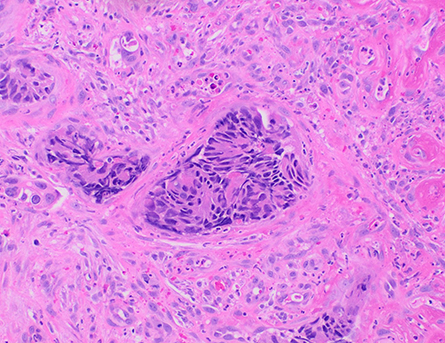From the journals: MCP
A new way to view colorectal cancer cell differentiation. Secretomics shed light on cells’ immune response. Targeting the signaling pathway convergence point. Read about papers on these topics recently published in the journal Molecular & Cellular Proteomics.
A new way to view colorectal cancer cell differentiation
Colorectal cancer is among the most diagnosed cancers. Its risk factors include genetics, aging and lifestyle choices, such as smoking. Treatment has proved difficult, as this type of cancer is heterogenous and often has an asymptomatic clinical course, resulting in late diagnosis. Identifying reliable biomarkers for diagnosis and disease progression is essential.

Research groups previously have determined that altered glycosylation states, in glycosphingolipid particularly, can be associated with malignant transformation in colon cancer. While protein glycosylation in this cancer is studied widely, glycosphingolipid expression of patterns and their contributions to colorectal cancer have yet to be explored.
In a recent study published in Molecular & Cellular Proteomics, Di Wang and collaborators at the Center for Proteomics and Metabolomics at Leiden University Medical Center in the Netherlands performed an in-depth analysis of glycosphingolipid glycans of 22 colorectal cancer cell lines using porous graphitized carbon nano–liquid chromatography coupled with electrospray ionization–mass spectrometry. The authors found that glycosphingolipid expression varies among different cell lines.
They also found that glycosphingolipid expression correlates with relevant glycosyltransferases involved in their biosynthesis as well as with transcription factors implicated in colon differentiation. The authors conclude that this glycomic study provides novel insights into glycosphingolipid glycan regulation for future functional studies in colorectal cancer research.
Secretomics shed light on cells’ immune response
Hepatocytes — cells in the liver that play essential roles in metabolism and detoxification —have important secretory and immunological functions. Inflammatory processes produce signals (such as cytokines interleukin-1 and -6) that induce the acute-phase response, which in turn provokes secretion of proteins with immunomodulatory functions to restore homeostasis.
The secretome of a cell or an organism consists of proteins secreted by the endoplasmic reticulum–Golgi secretory pathway and other direct or vesicle-based mechanisms. The systematic investigation of secreted proteins by mass spectrometry–based proteomics, however, has faced several challenges, as most approaches use serum-free culture conditions to avoid serum-induced interferences, thus negatively affecting the observable time window, cellular functions and viability.
In a recent article in Molecular & Cellular Proteomics, Sascha Knetch and colleagues at GlaxoSmithKline in Germany developed an interval-based secretomics workflow that determines protein-secretion rates in short serum-free time windows. The authors also implemented a labeling strategy in which they were able to pull up to 11 protein samples into a single mass spectrometry run. This approach allowed for the first comprehensive analysis of time-dependent secretion of liver cell models in response to these pro-inflammatory cytokines.
Targeting the signaling pathway convergence point
PI3K–mTOR and MEK/MAPK signaling pathways are essential for the regulation of cell survival and other cellular functions. In addition, they are the most frequently dysregulated pathways in cancer.
Some cancer therapies based on kinase inhibitors are effective in tumors that are addicted to prosurvival signals and target individual members within these pathways. This leads to drug resistance and transient responses. To overcome this limitation, researchers are now investigating cotreatments with PI3K/AKT and MEK/MAPK inhibitors; however, the mechanisms leading to sensitivity remain unclear.
In a recent Molecular & Cellular Proteomics article, Maruan Hijazi and collaborators at the Centre for Genomics and Computational Biology at Queen Mary University of London report developing a phosphoproteomics approach based on liquid chromatography– tandem mass spectrometry to study the effects of co-treatment on the kinase eEF2K, a convergence point for both pathways.
The authors found that inhibition of eEF2K by siRNA or with a small-molecule inhibitor reversed the anti-proliferative effects of the cotreatment with PI3K plus MEK inhibitors in a cell model–specific manner. The authors conclude that eEF2K is a key mediator of these pathways and a target for synergistic cotreatment in cancer cells.
Enjoy reading ASBMB Today?
Become a member to receive the print edition four times a year and the digital edition monthly.
Learn moreGet the latest from ASBMB Today
Enter your email address, and we’ll send you a weekly email with recent articles, interviews and more.
Latest in Science
Science highlights or most popular articles

Fueling healthier aging, connecting metabolism stress and time
Biochemist Melanie McReynolds investigates how metabolism and stress shape the aging process. Her research on NAD+, a molecule central to cellular energy, reveals how maintaining its balance could promote healthier, longer lives.

Mapping proteins, one side chain at a time
Roland Dunbrack Jr. will receive the ASBMB DeLano Award for Computational Biosciences at the ASBMB Annual Meeting, March 7–10, just outside of Washington, D.C.

Exploring the link between lipids and longevity
Meng Wang will present her work on metabolism and aging at the ASBMB Annual Meeting, March 7-10, just outside of Washington, D.C.

Defining a ‘crucial gatekeeper’ of lipid metabolism
George Carman receives the Herbert Tabor Research Award at the ASBMB Annual Meeting, March 7–10, just outside of Washington, D.C.

The science of staying strong
Muscles power every movement, but they also tell the story of aging itself. Scientists are uncovering how strength fades, why some species resist it and what lifestyle and molecular clues could help preserve muscle health for life.

Bacteriophage protein could make queso fresco safer
Researchers characterized the structure and function of PlyP100, a bacteriophage protein that shows promise as a food-safe antimicrobial for preventing Listeria monocytogenes growth in fresh cheeses.

